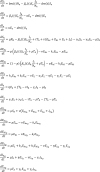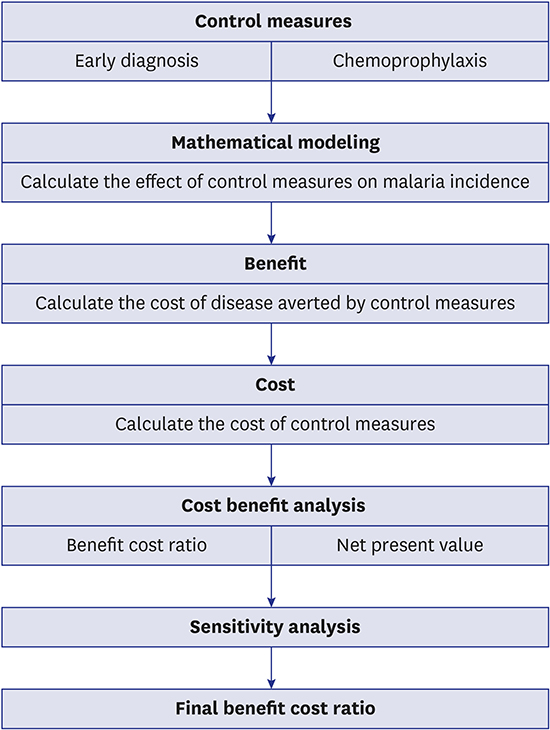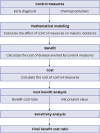1. Fritz RF, Andrews JM. Imported and indigenous malaria in the United States, 1952. Am J Trop Med Hyg. 1953; 2(3):445–456.

2. Yeom JS, Ryu SH, Oh S, Choi DH, Song KJ, Oh YH, et al. Evaluation of anti-malarial effects of mass chemoprophylaxis in the Republic of Korea army. J Korean Med Sci. 2005; 20(5):707–712.

3. Greenwood B. The use of anti-malarial drugs to prevent malaria in the population of malaria-endemic areas. Am J Trop Med Hyg. 2004; 70(1):1–7.

4. Park JW, Jun G, Yeom JS.
Plasmodium vivax malaria: status in the Republic of Korea following reemergence. Korean J Parasitol. 2009; 47:Suppl. S39–S50.
5. Mueller I, Galinski MR, Baird JK, Carlton JM, Kochar DK, Alonso PL, et al. Key gaps in the knowledge of Plasmodium vivax, a neglected human malaria parasite. Lancet Infect Dis. 2009; 9(9):555–566.
6. Tediosi F, Maire N, Smith T, Hutton G, Utzinger J, Ross A, et al. An approach to model the costs and effects of case management of Plasmodium falciparum malaria in sub-saharan Africa. Am J Trop Med Hyg. 2006; 75(2):Suppl. 90–103.
7. Kim SJ, Kim SH, Jo SN, Gwack J, Youn SK, Jang JY. The long and short incubation periods of Plasmodium vivax malaria in Korea: the characteristics and relating factors. Infect Chemother. 2013; 45(2):184–193.
8. McKenzie FE, Jeffery GM, Collins WE. Gametocytemia and fever in human malaria infections. J Parasitol. 2007; 93(3):627–633.

9. Bacaër N, Guernaoui S. The epidemic threshold of vector-borne diseases with seasonality: the case of cutaneous leishmaniasis in Chichaoua, Morocco. J Math Biol. 2006; 53(3):421–436.
10. Nah K. Malaria dynamics with long latent period in hosts [dissertation]. Szeged, Hungary: University of Szeged;2015.
11. Diekmann O, Heesterbeek JA, Roberts MG. The construction of next-generation matrices for compartmental epidemic models. J R Soc Interface. 2010; 7(47):873–885.

12. Kwon KS, Jung CS, Baek SG, Hwang DH, Kang SW, Park SJ. Cost-effectiveness analysis of the prophylactic agents for Malaria in the ROK. J Korean Mil Med Assoc. 2002; 33(1):45–54.
13. Kim YH, Shin SJ, Park JY, Jung YG, Kim JM, Lee TJ, et al. Costing Methods in Healthcare. Seoul, Korea: National Evidence-based Healthcare Collaborating Agency;2013.
14. Lee JH, Choi SK. Skills of Korean: Empirical Analysis and Future Strategies. Sejong, Korea: Korea Development Institute;2015.
15. Korea Centers for Disease Control and Prevention. Study on Prevalence of Antibodies Specific to Plasmodium Vivax in Endemic Regions of Vivax Malaria. Cheongwon, Korea: Korea Centers for Disease Control and Prevention;2013.
16. Korea Centers for Disease Control and Prevention. Mathematical Modelling on P. Vivax Malaria Transmission and Development of its Application Program. Cheongwon, Korea: Korea Centers for Disease Control and Prevention;2008.
17. Endo A, Nishiura H. Transmission dynamics of vivax malaria in the republic of Korea: effectiveness of anti-malarial mass chemoprophylaxis. J Theor Biol. 2015; 380:499–505.

18. Ishikawa H, Ishii A, Nagai N, Ohmae H, Harada M, Suguri S, et al. A mathematical model for the transmission of Plasmodium vivax malaria. Parasitol Int. 2003; 52(1):81–93.
19. Hethcote HW. The mathematics of infectious diseases. SIAM Rev Soc Ind Appl Math. 2000; 42(4):599–653.

20. Brauer F, Castillo-Chavez C. Mathematical Models in Population Biology and Epidemiology. New York, NY: Springer;2001.
21. Anderson RM, May RM. Infectious Diseases of Humans. Oxford, United Kingdom: Oxford University Press;1991.
22. White MT, Conteh L, Cibulskis R, Ghani AC. Costs and cost-effectiveness of malaria control interventions--a systematic review. Malar J. 2011; 10(1):337.

23. Chang KS, Yoo DH, Ju YR, Lee WG, Roh JY, Kim HC, et al. Distribution of malaria vectors and incidence of vivax malaria at Korean army installations near the demilitarized zone, Republic of Korea. Malar J. 2016; 15(1):259.

24. Yoo DH, Shin EH, Park MY, Kim HC, Lee DK, Lee HH, et al. Mosquito species composition and Plasmodium vivax infection rates for Korean army bases near the demilitarized zone in the Republic of Korea, 2011. Am J Trop Med Hyg. 2013; 88(1):24–28.
25. Lee HW, Shin EH, Cho SH, Lee HI, Kim CL, Lee WG, et al. Detection of vivax malaria sporozoites naturally infected in Anopheline mosquitoes from endemic areas of northern parts of Gyeonggi-do (Province) in Korea. Korean J Parasitol. 2002; 40(2):75–81.
26. Foley DH, Klein TA, Lee IY, Kim MS, Wilkerson RC, Harrison G, et al. Mosquito species composition and Plasmodium vivax infection rates on Baengnyeong-do (island), Republic of Korea. Korean J Parasitol. 2011; 49(3):313–316.
27. Foundation for Innovative New Diagnostics (CH). Malaria Rapid Diagnostic Tests: an Implementation Guide. Geneva, Switzerland: Foundation for Innovative New Diagnostics;2013.










 PDF
PDF Citation
Citation Print
Print







 XML Download
XML Download